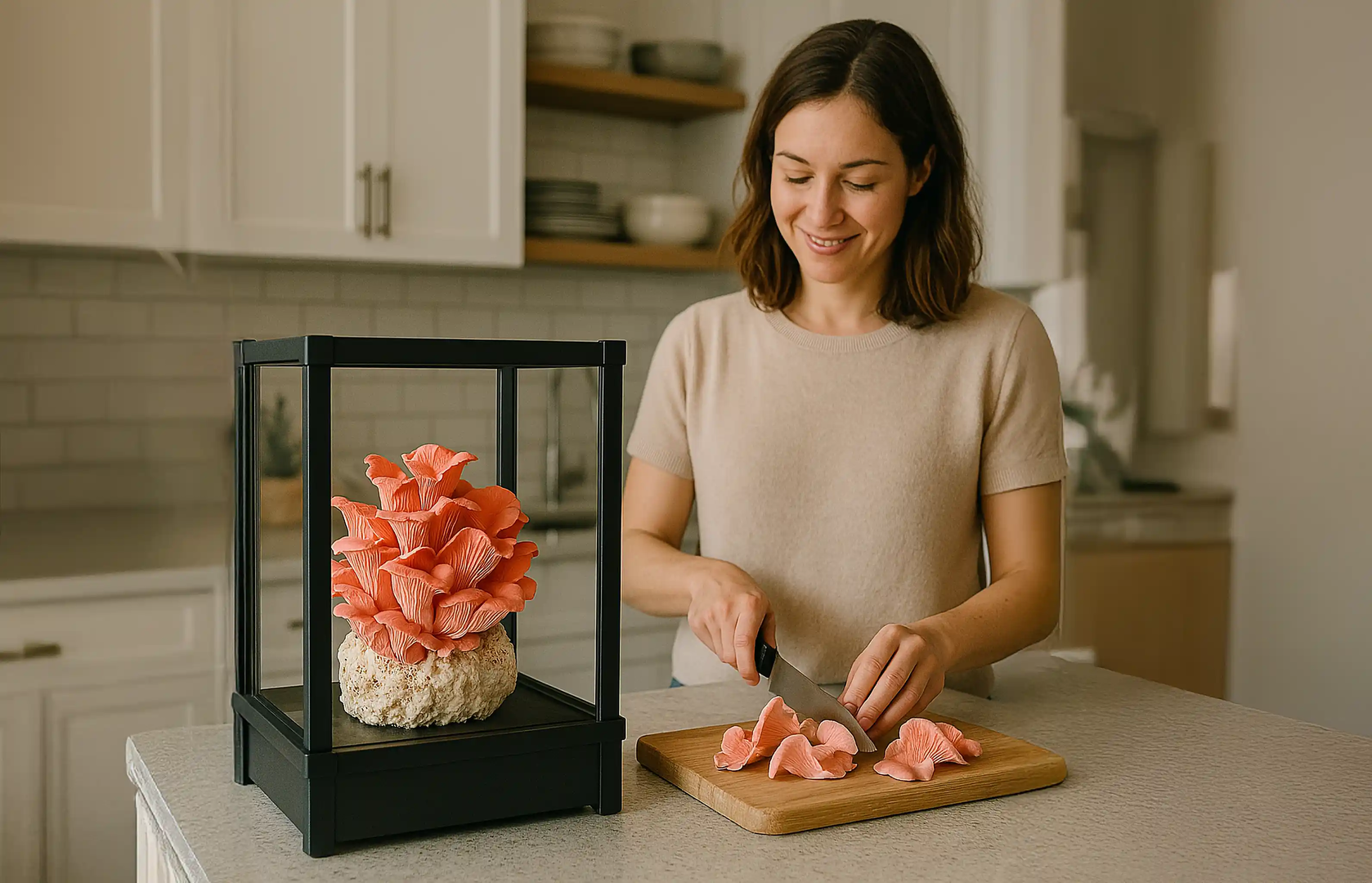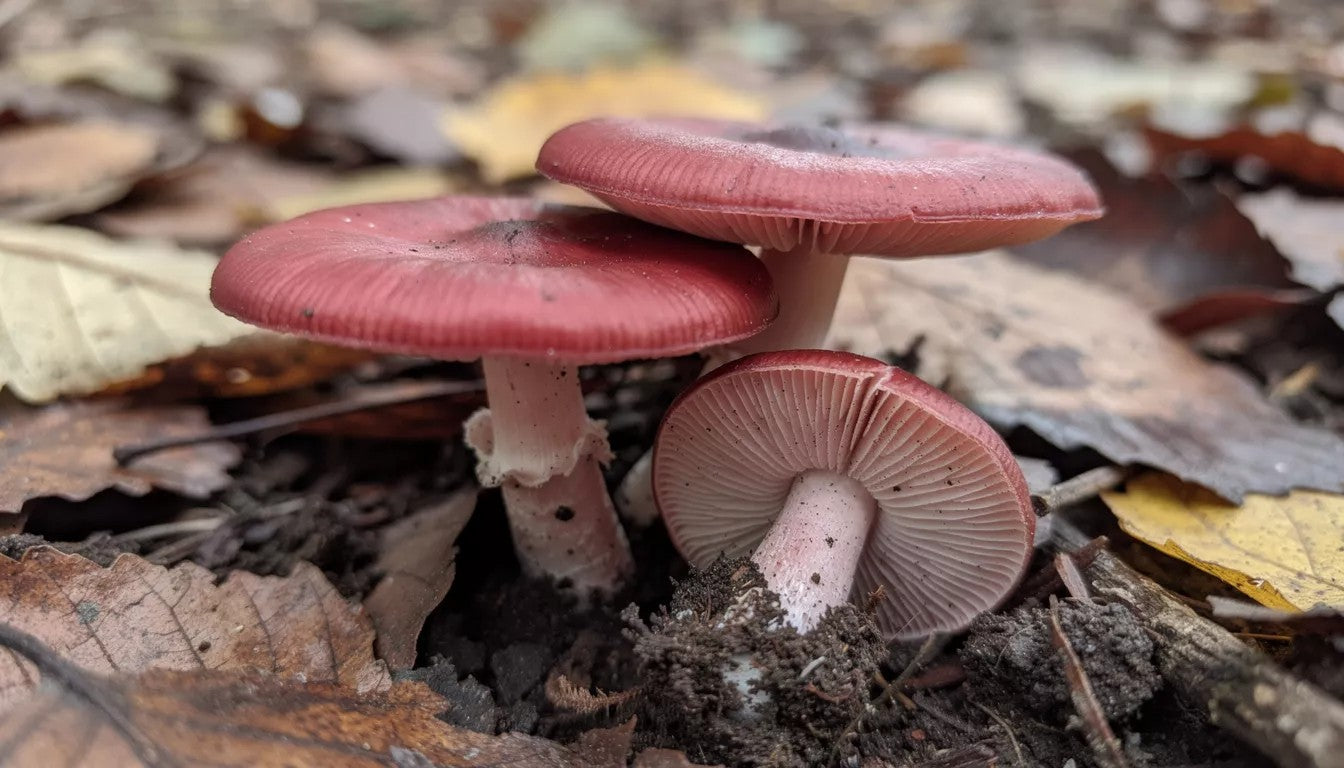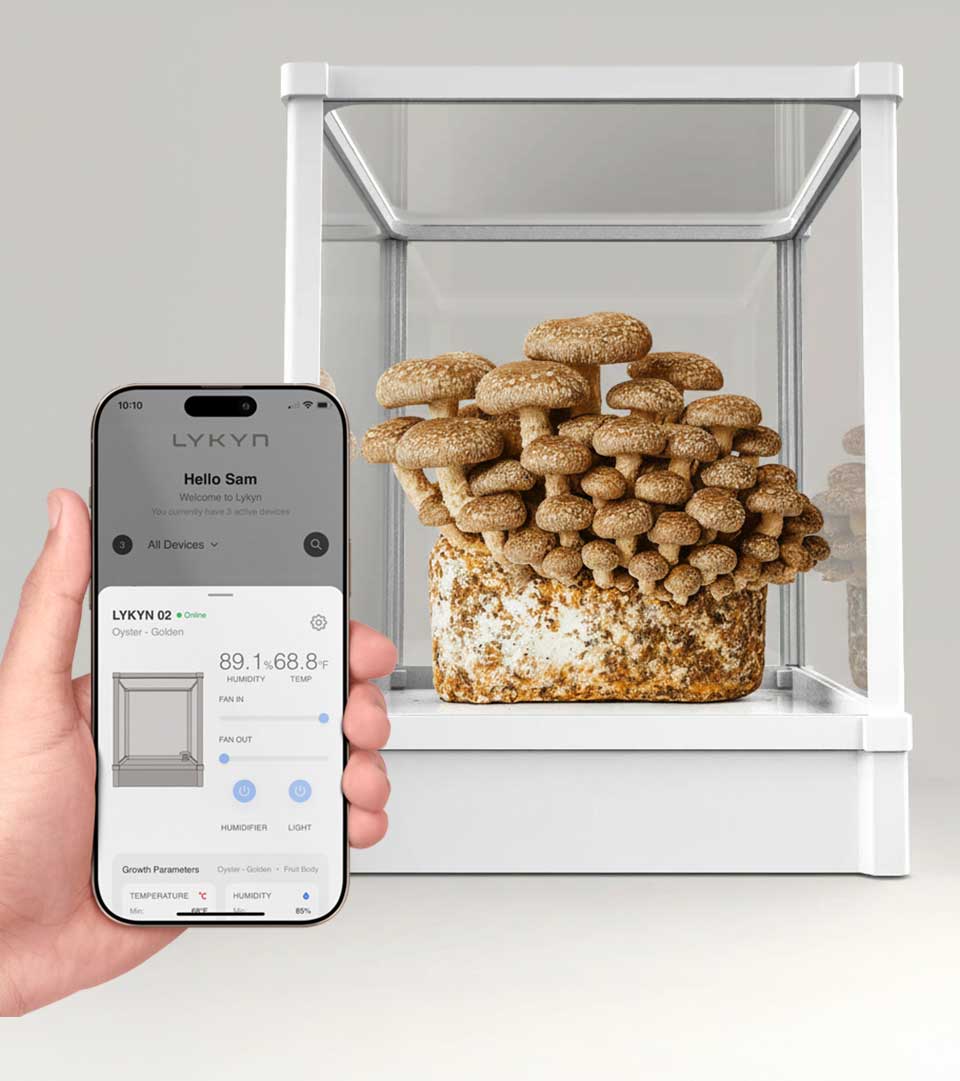Choosing the right mushroom growing kit can feel overwhelming with so many options flooding the market. Should you go traditional or smart? Basic blocks or fully automated chambers? Budget-friendly or premium investment?
The truth is, the "best" mushroom kit depends entirely on your specific situation—your experience level, available space, budget, time commitment, and what species you want to grow. This comprehensive guide will walk you through every critical factor to consider when selecting a mushroom growing kit, ensuring you make an informed decision that leads to successful harvests.
Whether you're a complete beginner curious about growing Lion's Mane for cognitive health or an experienced cultivator ready to upgrade to automated systems, this guide has you covered. Let's dive into the essential considerations that will help you choose the perfect mushroom growing kit for your needs.

Understanding Your Growing Goals and Experience Level
Before comparing features and prices, take a moment to honestly assess your situation. This self-evaluation will immediately narrow your options and prevent buyer's remorse.
Are You a Complete Beginner?
If you've never grown mushrooms before, prioritize simplicity and forgiveness. Your first kit should build confidence, not frustrate you with complex procedures or finicky requirements.
Look for kits labeled "beginner-friendly" with pre-colonized substrates that are ready to fruit. These eliminate the sterilization and inoculation processes that often overwhelm newcomers. The best beginner kits require minimal daily maintenance—ideally just misting and monitoring.
Traditional spray-and-grow block kits work well for beginners willing to commit to twice-daily misting routines. However, if you travel frequently or have a busy schedule, consider smart automated systems like the LYKYN Smart Mushroom Grow Kit that handle environmental control for you.
Do You Have Growing Experience?
Experienced growers may find basic kits limiting. If you understand contamination prevention, substrate preparation, and environmental parameters, you might prefer customizable systems that offer greater control and higher yield potential.
Intermediate to advanced growers often appreciate monotub systems, larger-scale setups, or specialized equipment for specific species. You may also want kits that accommodate custom substrate mixes or allow experimentation with different cultivation techniques.
What's Your Time Commitment?
Be realistic about how much daily attention you can provide. Traditional block kits require misting 2-3 times daily without fail. Missing misting sessions can dry out your mushrooms and stunt growth.
If you can dedicate time to manual care, traditional kits work beautifully and cost less. However, if your schedule is unpredictable or you travel regularly, automated humidity control becomes essential rather than optional.
Key Features That Define Quality Mushroom Kits
Understanding what separates excellent kits from mediocre ones helps you evaluate options objectively. Here are the critical features that impact your growing success.
Substrate Quality and Composition
The substrate—the material mushrooms grow on—fundamentally determines your yield potential. Quality kits use properly formulated, fully sterilized substrates optimized for specific mushroom species.
Pre-colonized vs. Uncolonized: Pre-colonized substrates (those already inoculated with mycelium) offer faster results and lower contamination risks. Uncolonized substrates require you to add spawn yourself, which adds complexity but costs less.
Substrate Type: Different mushrooms prefer different substrates. Oyster mushrooms thrive on straw or sawdust. Shiitake prefer hardwood. Lion's Mane grows well on supplemented sawdust. Ensure your kit's substrate matches your chosen species.
Supplementation: "Master Mix" and other supplemented substrates containing nutrients like soy hull or wheat bran typically produce higher yields than basic sawdust alone. Premium kits often use these enhanced formulations.
Environmental Control Systems
Mushrooms are notoriously picky about their growing conditions. They need specific humidity levels (usually 85-95%), fresh air exchange to remove CO2, appropriate temperatures (typically 60-75°F), and indirect light.
Manual Control (Traditional Kits): Basic kits provide simple humidity tents and rely on you to spray water regularly. This approach works but requires consistent attention and introduces contamination risks each time you open the growing environment.
Automated Control (Smart Systems): Advanced kits integrate sensors, humidifiers, and fans that automatically maintain optimal conditions. The LYKYN chamber exemplifies this approach, using app-controlled systems to monitor and adjust humidity, airflow, and temperature without manual intervention.
Hybrid Systems: Some mid-range kits offer partial automation—perhaps an automatic humidifier but manual fan control. These provide convenience without the premium price of fully automated systems.
Contamination Protection
Contamination ruins mushroom grows more than any other factor. Quality kits incorporate multiple contamination barriers:
- HEPA filtration on air intake prevents airborne contaminants
- Sealed growing chambers minimize exposure to environmental mold spores
- Pre-sterilized components eliminate contamination sources
- Waterproof designs prevent moisture from compromising filtration
Smart systems that maintain closed environments have significant advantages here. The LYKYN Smart Mushroom Grow Kit eliminates the repeated opening required for manual misting, dramatically reducing contamination exposure.

Species Compatibility: Matching Kits to Mushrooms
Not all mushroom growing kits work equally well for all species. Some mushrooms are forgiving beginners, while others demand precise conditions.
Easy-to-Grow Species
Oyster Mushrooms (All Varieties): Blue, pink, golden, and pearl oyster mushrooms are incredibly forgiving. They tolerate temperature fluctuations, grow rapidly (often pinning within 7-10 days), and produce abundant yields. Oyster varieties make excellent first choices for any beginner kit.
Shiitake: While slightly slower than oysters, shiitake mushrooms are reliable and relatively easy. They prefer slightly cooler temperatures (60-75°F) and produce multiple flushes with proper care.
Intermediate Difficulty Species
Lion's Mane: This brain-boosting mushroom requires higher humidity than oysters and is more prone to drying out. However, with consistent moisture management or automated humidity control, Lion's Mane grows successfully. Check out our complete Lion's Mane mushroom cultivation guide for detailed growing tips.
Chestnut Mushrooms: These flavorful fungi need stable conditions but aren't overly demanding. They work well in automated systems or with diligent manual care.
Advanced Species
Reishi: These medicinal mushrooms require specific fruiting conditions and longer cultivation periods. Their tough, woody texture makes them unsuitable for culinary use but valuable for teas and tinctures. Learn more about Lion's Mane tincture recipes that apply similar extraction principles.
Maitake: Notoriously finicky about environmental conditions, maitake mushrooms challenge even experienced growers. Save these for after you've mastered easier species.
Turkey Tail: While not difficult to grow, turkey tail requires specific preparation methods for consumption. See our guide on how to prepare turkey tail mushrooms after harvesting.
Size, Space, and Yield Considerations
Where will you grow your mushrooms, and how much space can you dedicate? These practical questions significantly influence which kit suits you best.
Compact Countertop Kits
Small-footprint kits fit comfortably on kitchen counters or shelves, making them ideal for apartments or homes with limited space. Most traditional block kits measure roughly 10x8x8 inches when set up with humidity tents.
Smart chambers like LYKYN are designed with aesthetics in mind, looking more like attractive appliances than laboratory equipment. They typically occupy about the same space as a coffee maker—compact enough for urban living while accommodating standard mushroom blocks.
Large-Scale Systems
If you have dedicated grow space in a basement, garage, or spare room, larger systems like monotubs or Martha tents can produce significantly higher yields. These setups accommodate multiple blocks simultaneously and can generate pounds of mushrooms weekly once optimized.
Consider whether you need mushrooms for personal consumption or want surplus for gifting, selling, or extensive meal preparation. Your intended scale should match your kit size.
Expected Yields
Yield expectations vary dramatically by kit size and species. A standard 5-pound fruiting block typically produces:
- Oyster mushrooms: 1-2 pounds over 3-4 flushes
- Shiitake: 1-1.5 pounds over 2-3 flushes
- Lion's Mane: 0.75-1.5 pounds over 2-3 flushes
Premium substrates and optimal environmental control increase these yields. Automated systems generally outperform manual setups because they maintain more consistent conditions.
Budget Analysis: Understanding Price Ranges
Mushroom kits span a wide price spectrum. Understanding what you're paying for helps justify investments.
Budget Options ($20-40)
Entry-level block kits in this range provide basic, pre-colonized substrates with minimal accessories. Expect simple humidity tents and basic instructions.
Pros: Low barrier to entry, minimal financial risk, great for testing interest
Cons: Manual maintenance required, no environmental automation, potential for inconsistent results
Mid-Range Options ($40-120)
This category includes premium block kits, better substrate formulations, improved humidity systems, and sometimes basic automation features like automatic humidifiers.
Pros: Better yield potential, reduced maintenance, higher quality components
Cons: Still requires regular attention, limited automation
Premium Options ($120-400+)
Smart automated chambers and advanced monotub systems fall into this range. You're paying for sophisticated environmental controls, app integration, contamination barriers, and elegant designs suitable for living spaces.
The LYKYN Smart Mushroom Grow Chamber represents this premium category, offering complete automation that justifies the investment for serious growers or those wanting hassle-free cultivation.
Pros: Minimal maintenance, optimal growing conditions, multiple species compatibility, long-term reusability
Cons: Higher upfront cost
Cost Per Pound Analysis
When evaluating kit prices, calculate cost per pound of harvested mushrooms. A $30 kit producing 1 pound of mushrooms costs $30/pound. A $300 smart chamber producing 6 pounds over multiple grows costs $50/pound initially but decreases with each reuse.
Premium systems become economically attractive when you plan to grow mushrooms regularly over months or years. Budget kits work well for occasional growers or those testing the hobby before committing.

Essential Accessories and Included Components
Great mushroom kits come complete with everything needed for success. Evaluate what's included versus what requires separate purchase.
Must-Have Inclusions
Pre-colonized Substrate: The foundation of your grow should arrive ready to fruit, with visible mycelium throughout.
Humidity Tent or Chamber: Some containment system to maintain moisture around developing mushrooms is essential.
Growing Instructions: Clear, species-specific instructions with photos or videos prevent beginner mistakes.
Spray Bottle (for manual systems): If not automated, you'll need a fine-mist sprayer for daily watering.
Valuable Additions
Multiple Flushes Support: Information and materials for rehydrating blocks between flushes maximizes your investment.
Customer Support Access: Companies offering growing advice, troubleshooting help, and community forums add tremendous value, especially for beginners.
Replacement Guarantees: Contamination can occur despite best efforts. Kits backed by replacement guarantees reduce your risk.
Smart System Features
Automated kits should include:
- App connectivity for remote monitoring and control
- Integrated sensors for accurate environmental readings
- Automatic humidifier with adequate water capacity (2+ liters ideal)
- Fresh air exchange system with filtration
- LED lighting optimized for mushroom development
Making Your Final Decision: A Step-by-Step Approach
Now that you understand the key considerations, use this decision framework to choose your ideal mushroom kit:
Step 1: Set Your Budget
Determine how much you're willing to invest initially. Remember that quality kits provide better returns through higher yields and multiple uses.
Step 2: Assess Your Time Availability
Honest self-evaluation prevents purchasing kits that don't match your lifestyle. If you can't mist twice daily consistently, budget for automation.
Step 3: Choose Your Species
Beginners should start with oyster mushrooms or shiitake. Once you've succeeded with these, expand to Lion's Mane, turkey tail, or specialty varieties. Read our guide on growing turkey tail mushrooms for medicinal mushroom cultivation.
Step 4: Evaluate Your Space
Measure where you'll grow mushrooms. Ensure adequate space not just for the kit but for accessing it comfortably during maintenance.
Step 5: Research Brand Reputation
Read reviews, check contamination replacement policies, and verify companies actually deliver products (important given crowdfunding failures in the smart mushroom space).
Step 6: Consider Long-Term Value
If you anticipate growing mushrooms regularly, higher upfront investments in automation often pay off through convenience and consistent results over time.
Common Mistakes to Avoid When Choosing a Mushroom Kit
Learning from others' mistakes saves money and frustration. Avoid these frequent errors:
Choosing Based on Price Alone: The cheapest kit rarely provides the best value. Factor in yield potential, included components, and customer support when evaluating cost.
Ignoring Species Requirements: Buying a kit without verifying it suits your chosen mushroom species leads to poor results. Match substrate type and environmental capabilities to your target species.
Underestimating Maintenance Demands: Traditional kits require consistent daily attention. Skipping misting sessions compromises your harvest. Be realistic about your commitment capacity.
Overlooking Contamination Protection: Kits lacking proper filtration or sealed environments increase failure rates. Contamination wastes your time and money—invest in adequate protection.
Buying Based on Marketing Hype: Smart systems promised through crowdfunding often fail to deliver. Choose proven products from established companies with real customer reviews.
Not Planning for Multiple Flushes: Your first harvest is just the beginning. Quality kits provide guidance for obtaining 2-4 additional flushes from the same substrate.
Frequently Asked Questions About Choosing Mushroom Kits
What's the difference between fruiting blocks and grow bags?
Fruiting blocks are pre-colonized substrates formed into solid blocks, ready to fruit immediately after setup. They're encased in plastic bags but the substrate itself is consolidated. Grow bags contain loose substrate and spawn that colonize together over time. Fruiting blocks offer faster results (10-14 days to harvest) while grow bags require longer colonization periods (3-6 weeks) before fruiting. Beginners should choose fruiting blocks for quicker gratification and lower contamination risks.
Should I buy an automated system or start with a basic kit?
This depends on your budget, commitment level, and lifestyle. Start with basic kits if you're on a tight budget, can maintain twice-daily misting schedules, and want to learn hands-on growing fundamentals. Choose automated systems if you travel frequently, have limited time for maintenance, want consistently optimal conditions, or are growing species like Lion's Mane that require precise humidity control. Automated systems like the LYKYN chamber eliminate the learning curve and produce professional results from your first grow.
How many times can I reuse a mushroom growing kit?
Most fruiting block kits produce 2-4 flushes (harvest cycles) before the substrate exhausts its nutrients. After your first harvest, rehydrate the block by soaking it in cold water for several hours, then continue the growing process. Yields typically decrease with each subsequent flush. After exhausting the block, you can compost the spent substrate—it's excellent for gardens. Smart chambers and reusable equipment last for years with proper maintenance, accommodating countless new blocks over time.
What mushroom species is easiest for beginners to grow?
Oyster mushrooms (especially blue and pink varieties) are unanimously considered the easiest for beginners. They colonize quickly, tolerate environmental fluctuations, grow fast (7-10 days from setup to harvest), resist contamination better than most species, and produce abundant yields. Shiitake mushrooms rank second for ease, though they require slightly longer growing periods. After mastering oysters, try Lion's Mane or chestnuts before attempting advanced species like reishi or maitake.
Do smart mushroom chambers work with all mushroom types?
Yes, quality smart chambers with adjustable settings accommodate virtually all gourmet and medicinal mushroom species. The LYKYN app includes presets for different varieties, automatically adjusting humidity, airflow, and lighting for your selected species. This versatility makes smart systems excellent long-term investments—you can grow oysters this month, Lion's Mane next month, and shiitake after that, all with optimal conditions for each species. Traditional block kits are species-specific and can't be easily adapted to different varieties.
Key Takeaways: Choosing Your Perfect Mushroom Kit
Selecting the best mushroom growing kit requires balancing multiple factors: your experience level, available time, budget, growing goals, and space constraints. Beginners benefit most from forgiving species like oyster mushrooms in either automated systems or quality block kits with clear instructions. Experienced growers might prefer customizable systems offering greater control and scalability.
Smart automated chambers eliminate maintenance demands and contamination risks while delivering consistent, professional results. Though they require higher initial investment, they provide unmatched convenience and success rates. Traditional block kits offer affordable entry points for budget-conscious growers willing to commit to daily care routines.
Ultimately, the "best" kit is the one you'll actually use successfully. Choose based on realistic assessment of your situation rather than aspirational thinking about how much time you wish you had for mushroom cultivation.
Start Your Mushroom Growing Journey Today
Ready to begin cultivating fresh, nutritious mushrooms at home? The LYKYN Smart Mushroom Grow Chamber offers the easiest, most reliable path to mushroom growing success. With full automation, app-based controls, and elegant design, it brings professional-grade cultivation into your home without the professional learning curve.
Whether you're drawn to functional mushrooms for health benefits or gourmet varieties for culinary adventures, growing your own ensures maximum freshness and potency. You'll save money compared to buying premium mushrooms while enjoying the satisfaction of harvesting food you've grown yourself.
For more detailed growing guidance, explore our comprehensive resources on Lion's Mane mushroom growth stages, how to grow Lion's Mane at home, and our beginner's mushroom grow kit guide. These resources complement your chosen kit with species-specific knowledge that optimizes your results.
Don't wait to start this rewarding hobby. Choose your kit today and discover why thousands of home growers are embracing mushroom cultivation as both a practical food source and a fascinating connection to the incredible world of fungi.
Featured Snippet Summary
To choose the best mushroom kit, consider your experience level (beginners need simple, pre-colonized blocks), available time (busy schedules require automation), budget ($20-400+ range), target species (oysters easiest, reishi most challenging), and space constraints. Smart automated chambers like LYKYN eliminate maintenance while traditional blocks cost less but need daily misting. Match kit features to your specific situation for optimal results.














Share:
Top 5 Mushroom Growing Kits Reviewed: Your Complete Guide to Home Mushroom Cultivation in 2025
Mushroom Types Food: Your Complete Guide to 15 Delicious Edible Varieties